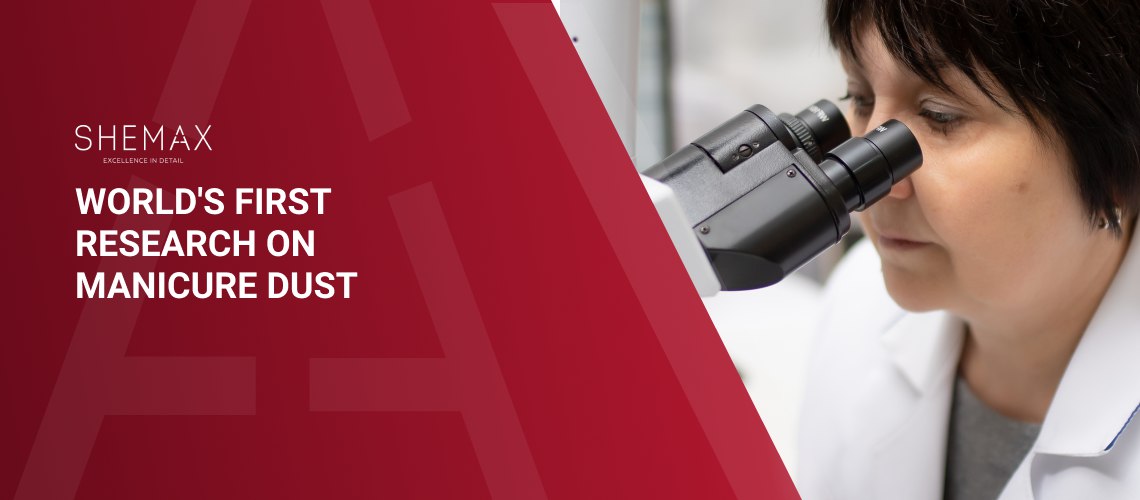Weltweit erste Forschung zu Manikürestaub

© SHEMAX Company 2021
The world's first official study of the characteristics of dust after a manicure procedure was conducted by SHEMAX, a Ukrainian manufacturer of professional equipment for beauty salons.SHEMAX has applied to one of the leading universities in Ukraine - Oles Honchar Dnipropetrovsk National University to conduct research experiments to study the characteristics of dust generated during the manicure.On April 22, 2021, the head of the research department of DNU, candidate of technical sciences Oleksiy Polishko and associate professor of chemical sciences Volodymyr Polonsky conducted a comprehensive analysis of dust after manicure, determined the size and shape of particles and them movement indoors during the working day.
Dust is a dangerous and harmful factor of production. Any industrial dust generated during the manicure procedure is a very dangerous factor and causes occupational chronic diseases.
The manicurist uses a professional nail file or a specialized electric device - a milling machine with various attachments - to create the shape of the nail, remove the remnants of working material or remove the old varnish. During the work, a large amount of dust is formed, which negatively affects the health of the manicurist.
When air is inhaled, manicure dust enters the lungs, the particles are trapped in the upper respiratory tract and cause irritation and even inflammation. The most harmful are particles smaller than 5 microns, which when ingested into the lungs contribute to the compaction of lung tissue and pneumoconiosis. Dust generated during the removal of artificial material can accumulate in the cabin air. Due to its small size, such dust remains in the air for a long time and easily enters the respiratory tract. Frequent contact with dust provokes diseases that increase depending on the professional experience of the beauty master.
Many microscopic particles in the dust structure have dangerously sharp edges and torn corners. Accumulating on the mucous membranes of the respiratory tract, eyes, and skin, they are fixed there and lead to chronic diseases. The complex effects of dust and harmful chemicals in the composition of materials can lead to the development of occupational diseases in manicurists.
Allergic bronchitis causes respiratory pathology. The cause of the disease is periodic contact with the allergen. Treatment is carried out with the use of antihistamines, antibiotics, corticosteroids. When the master repeatedly comes into contact with dust, which is an allergen, he is forced to regularly re-apply the drug.
Bronchial asthma, which has the character of chronic respiratory disease.
Chronic obstructive pulmonary disease restricts the movement of air in the airways due to the accumulation of various toxic substances.
The appearance of the disease on the eyes - conjunctivitis, provokes aerosol antiseptic, manicure dust, and fine particles of skin that settle on the mucous membrane of the eye. This leads to the development of an inflammatory process in the eyes.
Dermatic skin diseases from contact with dust. With constant exposure to allergens and neglect of treatment, dermatitis becomes chronic and progresses to more serious disease. It is eczema.
Fungal nail diseases. The infection is transmitted through the remnants of manicure dust, which is in the workplace of the master and in the air of the beauty salon.
The presence of dangerous toxic components in the manicure is like poison for the body. Varnish and acrylic contain a synthetic component - methacrylate. Most often it leads to allergies and is part of varnishes with a low price segment. In addition to methacrylate, manufacturers use several aggressive components: formaldehyde, toluene, dibutyl phthalate, acetophenone, butyl acetate, formaldehyde resins, nitrocellulose, camphor, rosin, diacetone alcohol.
1. Research of the form of dust for manicure
In the study to determine the shape of the dust for manicure used samples were obtained by a manicurist in one working day. For the study, the master did not use electrical equipment to collect dust, all samples were collected from the working surface of the manicure table to preserve the original appearance and transfer the actual weight of dust left after each client.
Dust samples were obtained by sawing nails with a Marathon 3 Champion cutter using a red hard alloy nozzle and a 180 nail file to shape the nails.
The room where the dust samples were collected is 4 x 4 meters with a ceiling height of 2.4 meters, where one window is installed. The office has one master, who has a desk, two chairs, a pedicure chair, a cabinet with sterilization equipment, a sink, and air conditioning.
Dust samples (Fig. 1) were obtained from 8 customers in one working day from one master without using a vacuum cleaner to collect dust. By all stages of a full-fledged manicure from the removal of the previous gel varnish and the application of a new layer, the following dust samples were obtained weighing: №1 - 0.90 g; №2 - 0.34 g; №3 - 0.41 g; №4 - 0.49 g; №5 - 0.67 g; №6 - 0.42 g; №7 - 0.41 g; №8 - 0.53 g.
As a result, we can conclude that on average at one working day at the workplace of 8 customers falls 4.17 g of dust, which can be seen with the eyes and measured by scales. But a large amount of dust remains in the air for a long time and moves from place to place.




